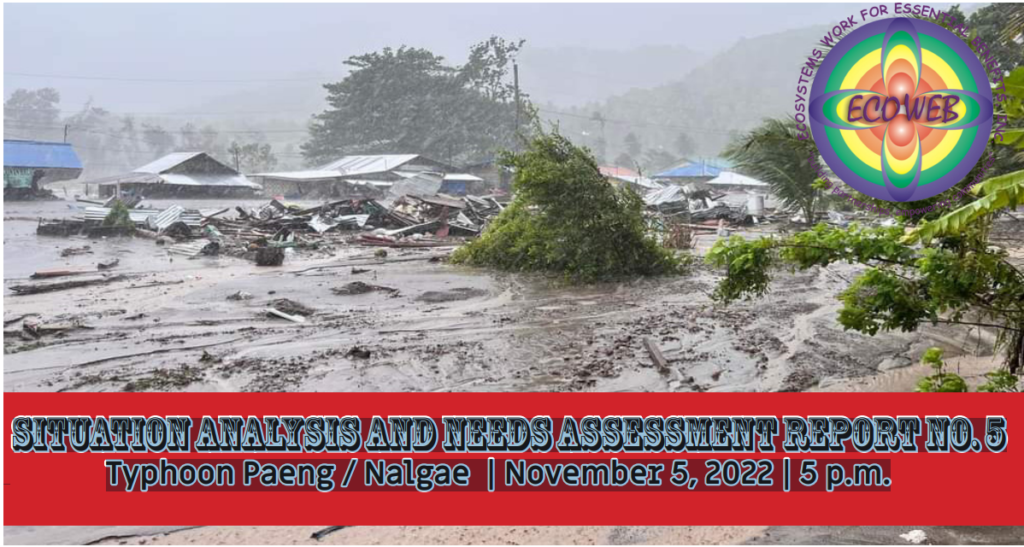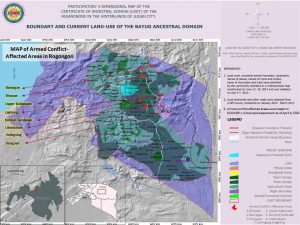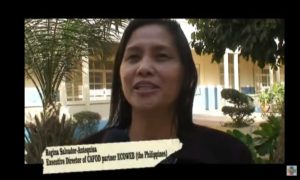
Typhoon Paeng left Philippines 520 munici- palities and cities, including BARMM, under the state of calamity1 after having six landfalls across Virac, Catanduanes; Caramoan, Camarines
Sur; and Buenavista, Quezon. Paeng’s fourth landfall was in Santa Cruz, Marinduque, fifth landfall in Sariaya, Quezon, and its sixth landfall in Baliuag, Bulacan on October 29, 2022.
The National Disaster Risk Reduction and Management Council (NDRRMC) recorded 30,248 damaged houses of which 2,775 are totally damaged. While Maguindanao evidently looked as the ground zero of PaengPH’s catastrophe which brought massive death in a landslide, but most infrastructure and houses damages are in Regions 5, 6, 7, 12 and Calabarzon.
State of Evacuees after PaengPH
Across the affected regions of the country, 102 areas reported having landslides.2
There are 155 persons reported dead and 34 persons are still missing.2
The Department of Social Welfare and Development (DSWD) reported a total of 1,249,680 families or 5,062,887 persons affected by severe flooding. There are also, 1,149,809 persons or 248,246 families that are displaced that are either staying evacuations or with their respective preferred from 9,274 barangays.5
Regions with highest record of displacements are Regions VI, BARMM, Calabarzon, Region V and Region 12.
Agriculture sector reported 119,532.91277 5 MTs of production loss among devastated crops which is equivalent to P 2. 7 B. Worst affected in terms of agricultural devastation are Regions 5 and Calabarzon as reported in NDRRMC.
The devastation that came along with typhoons increase the economic risks among affected populace whose resources, if there’s any, will be utilized for household-based recovery, specially those who have lost their loved ones, homes, properties, and agricultural products. This will further the poverty threshhold and incidences among regions.
In 2021, the Annual Per Capita Poverty Threshold and Poverty Incidence among Families with Measures of Precision by Region and Province in 20216 showed that the current affected regions have the following poverty incidences: 29.8% in BARMM, 11% in Region 1 or Ilocos Region; 11.7% in Region II or Cagayan Valley; 8.3% in Region 3 or Central Luzon; 7.2% in Region IV-A or Calabarzon; 15% in Mimaropa Region; 21.9% in Region V or Bicol region; 13.8% in Region VI or Western Visayas; 22.1% in Region VII or Central Visayas; 22.2% in Region VIII or Eastern Visayas; 23.4% in Region IX or Zamboanga Peninsula;19.2% in Region X or Northern Mindanao; 11.9% in Region XI or Davao Region; and 21.4% in Region XII (SOCCSKSARGEN).7
The poverty threshold and incidences in Cotabato is 31.3% and 23.8% in Sultan Kudarat.8 Likewise, Maguindanao has 29.8%; Basilan has 42.5%; Sulu has 51%; and Tawi-tawi has 28.1%9
.
Statistical data further demonstrated that the Income Gap, Poverty Gap and Severity of Poverty Measures in 2021 is estimated at 28.8% in BARMM, 29.9% in Caraga, 27.4% in Sultan Kudarat, 26.1% in Maguindanao, 29.5% in Basilan, 33.9% in Sulu, and 26.6% in Tawi-tawi.10
A comprehensive intervention for recovery is primeval to regain the normal lives and improve the affected region’s level of resiliency.
Humanitarian Protection Needs 11
The Ministry of Social Services and Development (MSSD) in BARMM with the support of UNHCR, UNICEF, and UNFPA, the Protection Cluster with the Child Protection (CP) and Gender-Based Violence (GBV) sub-clusters had its first cluster meeting on November 2, 2022 to discuss the results of the joint rapid and to formulate a comprehensive response plan addressing the main protection issues identified.
The protection cluster raised concerns on health risks in overpopulated evacuation centers exposing IDPs to the threat of COVID-19 and other illnesses.
Having been the most affected in Mindanao, around 470,000 individuals were reported to have been displaced in BARMM.
Some of the identified gaps in the provision of emergency needs are the need for more relief goods; emergency protection modular tents in evacuation centers; establishment of women and child-friendly spaces in evacuation centers to reinforce preventive measures to address child protection and gender based violence (CP-GBV)incidents; access to water, sanitation, and hygiene (WASH) facilities; and support for IDPs whose civil documentations were damaged during PaengPH’s onslaught.
The protection cluster also reported the need to provide proper information on the location of evacuation centers and the lack of available data in evacuation centers where age, gender, and diversity are disaggregated to hasten the appropriate interventions especially for vulnerable sectors such as children, lactating mothers, pregnant women,
persons with disability (PWDs), and elderly.
Among the causes of health risks identified are diarrhea and possible water-borne disease may increase if access to water, hygiene, and sanitation kits is not provided in evacuation centers and the stagnant floodwaters with lack of protective items such as mosquito net and repellants may expose IDPs
to the risk of dengue transmission. Lack of latrines and open defecation may open defecation will pose health problems too.
The protection cluster highlighted the need for hygiene kits, potable water, toiletries, diapers for infants and toddlers, and sanitary napkins, and other sanitary essentials for women and girls are urgent needs, including COVID-19 preventive measures.
They also call for the needed immediate deploy- ment of trained mental health and psychosocial support (MHPSS) to provide psychological first aid.

Damage to Infrastructures and Services
NDRRMC reported a total of 389 road sections and 82 bridges were affected of which 189 roads and 72 bridges are impassable.
About 280 cities/municipalities suffered power interruption but 105 areas have already their power supply restored.
There are 7 cities and municipalities with water supply interruptions while 42 areas in MIMAROPA, Region 5 and 8 have no access to communication lines.
There are still three (3) airports that are non-operational while six (6) others have resumed their normal business operations. A total of 385 domestic flights and 59 international flights were cancelled. About 110 seaports were affected but 27 ports are already operational.
Suspension of classes remained effectual in 670 cities and municipalities and in 230 workplaces. Of these schools, 617 or 1,856 classrooms are still being used as evacuation centers.11
PaengPH Effects to Mindanao
In Mindanao, Maguindanao, Parang, Upi and the entire BARMM have been declared under the state of calamity.
The most affected areas are BARMM, Maguindanao, Sultan Kudarat, Zamboanga city, Cotabato city, and North Cotabato. Less affected areas are the two towns of Dinagat Island, Butuan city of Agusan del Norte, the seven towns/city of Surigao del Norte, Tagoloan of Lanao del Norte, Lanao del Sur, Samal of Davao del Norte, and South Cotabato.12
BARMM recorded poverty incidence among families at 29.8 percent which translates to 0.23 mil- lion poor families; 37.4 percent of people in BARMM were poor in 2021 which translates to 1.71 million considered poor families or below the poverty threshold. Basilan province recorded 53.5%; Sultan Kudarat at 23.8%13, Lanao del Sur at 10.9%; Maguindanao at 38.0%; Sulu at 62.5%; Tawi-Tawi recorded 36.5% while Cotabato City recorded 39.7% based on the 2021 Family Income and Expenditure Survey (FIES).14
PaengPH has affected 202,598 families or 582,884 persons in 389 barangays in BARMM.15 These are from the four towns of Basilan, 30 towns in Maguindanao, a town in Lanao del Sur, Bongao of Tawitawi, and in Midsayap, Pigcawayan, and Pikit clusters of SGA.16
BARMM has recorded 51 dead, 14 missing, and 31 injured persons. Of those who died, 31 are confirmed from Datu Odin Sinsuat. PaengPH damaged partially damaged 341 houses and totally damaged 314 houses.17
BARMM’s airports in Awang suspended two flights and the ports in Jolo, Sulu suspended its trips due to bad weather condition.18 The Ministry of Basic, Higher, and Technical Edu- cation (MBHTE) likewise reported that 84 schools in BARMM were flooded.19
Damage to Infrastructures and Services
NDRRMC reported a total of 503 road sections and 119 bridges were affected of which 145 roads and 93 bridges are impassable.
About 359 cities/municipalities suffered power interruption but 252 areas have already their power supply restored.
There are 11 cities and municipalities with water supply interruptions while 38 areas in MIMAROPA, Region 5 and 8 have no access to communication lines. Airports are already operational but there are still 40 seaports that are non-operational.
Suspension of classes remained effectual in 666 cities and municipalities and in 223 workplaces. Of these schools, 617 or 1,856 classrooms are still being used as evacuation centers.11
Reported damages to infrastructures cost at an estimated amount of P 4.1 billion.
Maguindanao Focused
On November 1, 2022, during the Executive Situation Report in Datu Odin Sinsuat in Maguindanao, the province reported 124, 501 families or 622,505 families are affected by PaengPH from 30 of its 36 municipalities as of October 31, 2022. That is 78% of the provincial populace of 1,667,258.20 This is inclu- sive of 370 affected barangays which is 72.83% of the sum of 508 barangays in the entire province.21
Provincial governor of Maguindanao Mariam Mangondadatu reported 61 persons confirmed dead, 40 persons injured, and 17 persons considered missing.22 Among those who died, a number were buried in a landslide.
These landslides happened in barangay Kuslong, DOS; barangays Romonggaob and Looy of South Upi; and in barangays Maagabo Bayanga Sur, Upper Bayanga Sur Norte, and Kabugaw Sapad of Matanog town.23
PaengPH damaged 80 houses made of light materials in the province.24
Affected areas in the upland region are in Upi, South Upi, Barira, Matanog, and Maguindanao while the coastal zones of Datu Odin Sinsuat, Datu Blah Sinsuat Maguindanao also bear the brunt of the inundation.25 Other affected lowland areas are in Talayan, Gindulungan, Northern Kabuntalan, and Ampatuan. There were 172 barangays that were inundated by flooding in the plains of Maguindanao while there are
198 barangays were affected in the northern side of the
province. 26
As to their infrastructures, there were ten (10)27 damaged bridges that are declared impassable. Damaged livestocks and poultry are estimated at P2.4 million across Datu Odin Sinsuat, Sultan Kudarat, Sultan mastura, and North Upi. 28
Power lines of MAGELCO, a cooperative power distributor utility, estimated its infrastructure damages to P 30 million, inclusive of metering and some transformers which made Datu Blah Sinsuat, Datu Piang, and Parang without power supply.29
Governor Mangondadatu likewise pleaded to PSALM, NEA, and NGCP to consider its unpaid power consumption which soared to P 3 billion debt and their notice of electric supply disconnection.30 She also appealed to President Ferdinand Marcos to support them to prevent power disconnection in Maguindanao.31
Mangondadatu cited that among the most needed necessities in the evacuation centers are medicines for children who are suffering fever and cough.32
Indigenous Peoples affected, too
The indigenous peoples suffered the effects of typhoon PaengPH too, but which is often not reflected as a disaggregated data on gender and indigenous populace, albeit the fact that most of them are in marginalized and geographically disadvantaged com- munities.
In Luzon –across Regions 1, 2, Caraballo Moun- tains, and along Sierra Madre — affected communities included diverse indigenous populace. These tribes are the Agutaynen, Tagbanua, Cagayanen, Cuyunon, Ke’ney, Batak, Pala’wan, Molbog, Iraya Mangyan, Hanunuo Mangyan, Alangan Mangyan, Buhid Mangyan, Tadyawan Mangyan, Batangan Mangyan, Gubatnon Mangyan, Ratagnon Mangyan, Ati, Ati Sulod/Bukidnon, Magahat Korolanos, Ata, Bukidnon, Escaya,
Badjao, and Kongking in Region I; the tribes in Agta, Kalanguya, Bugkalot, Isinai, Gaddang , Aggay , Dumagat , lbanag, Itawis, and lvatan in Region II; and, the tribes of Aeta, Negrito. Baluga, Pugot, Abell ing, Agta, Dumagat, Remontado, Bugkalot, Cimaron, Kabihug, Tabangnon, Abiyan, (Aeta), Isarog, and ltom in the ranges of Sierra Madre.
In Caraga and Agusan provinces, affected indigenous populace are Manobo, Mandaya, Mansaka, Dibabawon, Banwaon. Bagobo, Ubo Manobo, Tagakaolo, Talaingod, Langilan, Mamanwa, Higaonon, Blaan, T’boli, Kalagan, Tagabawa, Mangguangan, Tigwahanon, Sangil, and Agusan Manobo.
Meanwhile, in Central Mindanao – where Sultan Kudarat and Maguindanao are located, affected tribes are Aromanen, Tiruray, Bagobo, Ubo Manobo, Subanen, Maguindanao, Maranao, Iranon, Karintik Blaan, and Teduray Lambangian.
The landslides in Sultan Kudarat and in Maguindanao reportedly victimized indigenous people who relied in farming as source of living.
Civil society saw the need to have a disaggregated data of indigenous peoples in disaster management because there is sensitivity with respect to their culture, gender and care for women, and they have unique indigenous knowledge systems and practices in disaster management and recovery. This is also consistent to the protection of their culture and traditions, based on their cultural diversity, customs, beliefs, and institutions.
PaengPH Out, QueeniePH (Banyan) In
PaengPH intensifies further as it continues to move over the West Philippine Sea at 15 km/h with a maximum sustained winds of 110 km/h near the center and gustiness of up to 135 km/h.33 Light to moderate with at times heavy rains still possible over Ilocos Region, Cordillera Administrative Region,
Cavite, Batangas, the southern portion of Quezon, Western Visayas, Babuyan Islands, MIMAROPA, and the rest of Central Luzon. Flooding and rain-induced landslides are possible remained possible.34
TCWS No. 1 is still raised over Abra, the western portion of Benguet, the southern portion of Ilocos Norte, Ilocos Sur, La Union, the central and western portions of Pangasinan, the central and western portions of Tarlac, and the northern and central portions Zambales.35
PaengPH was estimated based on all available data at 400 km West of Sinait, Ilocos Sur and will be out of the Philippine Areas of Responsibility (PAR) by November 3, 2022.36
But as PaengPH pulled out of the Philippines, Mindanao braces to the entry of QueeniePH (Banyan) which was estimated based on all available data at 450 km East Southeast of Hinatuan, Surigao del Sur (7.4°N, 130.3°E) with maximum sustained winds of 65 km/h near the center and gustiness of up to 80 km/h. It is moving Westward at 20 km/h.37
Flashfloods or landslides are expected due to moderate or heavy rain in Bataan, Zambales, Palawan, Occidental Mindoro and Western Visayas with the trough of PaengPH.
QuenniePH is forecasted to bring rain and thunderstorm in Caraga and Davao Region. By 8 p.m. on November 1, QueeniePH is forecasted located in 390 km East of Surigao City, Surigao del Norte with an intensity of 45 km/h as a tropical depression moving west-northwest at 15 km/h. By November 2, QueeniePH will be 265 km Northeast of Hinatuan, Surigao del Sur with maintained intensity as a tropical depression. It has a low tendency of becoming a typhoon as it move northwest in a speed of 10km/h. The rest of Mindanao will have partly cloudy skies with isolated rainshowers or thunderstorms due to localized thunderstorms.38 Light to moderate winds from the southwest to south with slight to moderate seas.
QueeniePH will have an effect in Western Visayas, Occidental Mindoro, and Palawan including Kalayaan Islands will have cloudy skies with scattered rainshowers and thunderstorms due to the trough of STS (formerly Paeng).39 The rest of Visayas will have partly cloudy to cloudy skies with isolated rainshowers or thunderstorms due to localized thunderstorms.
Strong winds from the Southwest to Southeast will prevail over Palawan including Kalayaan Islands and Occidental Mindoro with rough seas. Light to moderate winds from the Southwest to South will prevail over the Visayas with slight to moderate seas.
Warning for Farmers and Fishers
For agriculture, it will still be rainy with thunderstorm in Ilocos Sur, La Union, Pangasinan.40 The rest of the country will be cloudy.41 In areas affected by PaengPH and QueeniePH wet weather cases “ fungal development and can cause damage to stored farm products, reduce the quality, viability and market price of the grains. Thus, it is advised to keep barns and crop storage rooms in good, dry, and well-ventilated condition.”42
Moderate to rough seas will be experienced over the rest of the archipelago. Gale warning is raised over the eastern seaboards of Southern Luzon and Visayas (the northern and eastern coasts of Quezon including Polillo Islands, Camarines Norte, the northern and eastern coasts of Camarines Sur, Catanduanes, the eastern coast of Albay, the eastern coast of Sorsogon, Northern Samar, and Eastern Samar), the eastern seaboards of Northern and Central Luzon (the eastern coast of Cagayan, Isabela, and Aurora), the northern and western seaboards of Northern Luzon (Batanes, the northern coast of Cagayan including Babuyan Islands, Ilocos Norte, Ilocos Sur, La Union, and Pangasinan), and the eastern seaboard of Mindanao (the eastern coast of Surigao Del Norte including Siargao and Bucas Grande Islands, the eastern coast of Dinagat Islands, Surigao Del Sur, and the eastern coast of Davao Oriental).43 Fishing boats and other small seacraft are advised not to venture out into the sea while larger sea vessels are alerted against big waves.

EndNotes
1 NDRRMC (Nov 5, 2022. SitRep No. 16 for TS PAENG, Philippines. Web: https://monitoring-dashboard.ndrrmc.gov.ph/assets/uploads/situations/SitRep_No_16_for_STS_PAENG_2022.pdf ;
2 NDRRMC (October 31, 2022). SitRep No. 8 for TS PAENG, Philippines. Web: https://monitoring-dashboard.ndrrmc.gov.ph/assets/uploads/
situations/SitRep_No__8_for_TS_PAENG_2022_.pdf and https://monitoring-dashboard.ndrrmc.gov.ph/assets/uploads/situations/summary_SitRep_No__8_for_TS_PAENG_2022_.pdf, and https://monitoring-dashboard.ndrrmc.gov.ph/assets/uploads/situations/detailed_SitRep_No__8_
for_TS_PAENG_2022_.pdf and NDRRMC (Nov 5, 2022. SitRep No. 16 for TS PAENG, Philippines. Web: https://monitoring-dashboard.ndrrmc.
gov.ph/assets/uploads/situations/SitRep_No_16_for_STS_PAENG_2022.pdf
3 NDRRMC.
4 DSWD-DROMIC (2022). DSWD DROMIC Report. DSWD DROMIC Report #21 on Severe Tropical Storm “Paeng” as of 5 November 2022,
6 am, DROMIC-DSWD Facebook Page and , DROMIC-DSWD. https://dromic.dswd.gov.ph/wp-content/uploads/2022/11/DSWD-DROMICReport-21-on-Severe-Tropical-Storm-Paeng-as-of-05-November-2022-6AM.pdf and NDRRMC (Nov 5, 2022. SitRep No. 16 for TS PAENG,
Philippines. Web: https://monitoring-dashboard.ndrrmc.gov.ph/assets/uploads/situations/SitRep_No_16_for_STS_PAENG_2022.pdf
5 DSWD-DROMIC (2022). DSWD DROMIC Report #21 on Severe Tropical Storm “Paeng” as of 5 November 2022, 6 am, DROMIC-DSWD
Facebook Page and , DROMIC-DSWD. https://dromic.dswd.gov.ph/wp-content/uploads/2022/11/DSWD-DROMIC-Report-21-on-SevereTropical-Storm-Paeng-as-of-05-November-2022-6AM.pdf and NDRRMC (Nov 5, 2022. SitRep No. 16 for TS PAENG, Philippines. Web: https://
monitoring-dashboard.ndrrmc.gov.ph/assets/uploads/situations/SitRep_No_16_for_STS_PAENG_2022.pdf
6 PSA (2021). 2021 Full Year Official Poverty Statistics Tables, Philippines.
7 PSA (2021). 2021 Full Year Official Poverty Statistics Tables, Philippines.
8 PSA (2021). 2021 Full Year Official Poverty Statistics Tables, Philippines.
9 PSA (2021). 2021 Full Year Official Poverty Statistics Tables, Philippines.
10 PSA (2021). 2021 Full Year Official Poverty Statistics Tables, Philippines.
11 UNHCR (The UN Refugee Agency) ( Nov. 4, 2022). STS Nalgae (Paeng) Aftermath Emergency Situation Report, 29 October — 04 November
2022, Issue No. 1., Cotabato City, Philippines
12 NDRRMC (Nov 5, 2022. SitRep No. 16 for TS PAENG, Philippines. Web: https://monitoring-dashboard.ndrrmc.gov.ph/assets/uploads/situations/SitRep_No_16_for_STS_PAENG_2022.pdf
13 DSWD DROMIC Report # 9 on Severe Tropical Storm Paeng as of October 30, 2022, 6 a.m., pp. 16-17 of 55. https://dromic.dswd.gov.ph/wpcontent/uploads/2022/10/DSWD-DROMIC-Report-9-on-Severe-Tropical-Storm-Paeng-as-of-30-October-2022-6AM.pdf
14 PSA SOCCKSARGEN Region. 2021 First Semester Poverty Statistics Sultan Kudarat http://rsso12.psa.gov.ph/sites/default/files/R12-
IG2022-011_SULTAN%20KUDARAT.png and PSA (2021). 2021 Full Year Official Poverty Statistics Tables, Philippines.
15 Philippine Statistics Authority (October 13, 2022). 2021 Full Year Official Poverty Statistics. Web: http://rssoarmm.psa.gov.ph/release/content/
press/55883 and http://rssoarmm.psa.gov.ph/sites/default/files/015%202021%20Full%20Year%20Official%20Poverty%20Statistics.pdf
16 NDRRMC.
17 BARMM READi.
18 BARMM READi.
19 BARMM READi.
20 BARMM READi.
21 RTVM Presidential Broadcast. https://www.youtube.com/watch?v=nSW_qply2wM
22 RTVM Presidential Broadcast. https://www.youtube.com/watch?v=nSW_qply2wM
23 RTVM Presidential Broadcast.
24 RTVM Presidential Broadcast.
25 RTVM Presidential Broadcast.
26 RTVM Presidential Broadcast.
27 RTVM Presidential Broadcast.
28 RTVM Presidential Broadcast.
29 RTVM Presidential Broadcast.
30 RTVM Presidential Broadcast.
31 RTVM Presidential Broadcast.
32 RTVM Presidential Broadcast.
33 DOST-PAGASA. Tropical Cyclone Bulletin #29. Severe Tropical Storm Paeng issued at 5:00 p.m., 31 October 2022, valid until 11 pm. Web:
https://www.pagasa.dost.gov.ph/tropical-cyclone/severe-weather-bulletin/1#flood
34 DOST-PAGASA.








